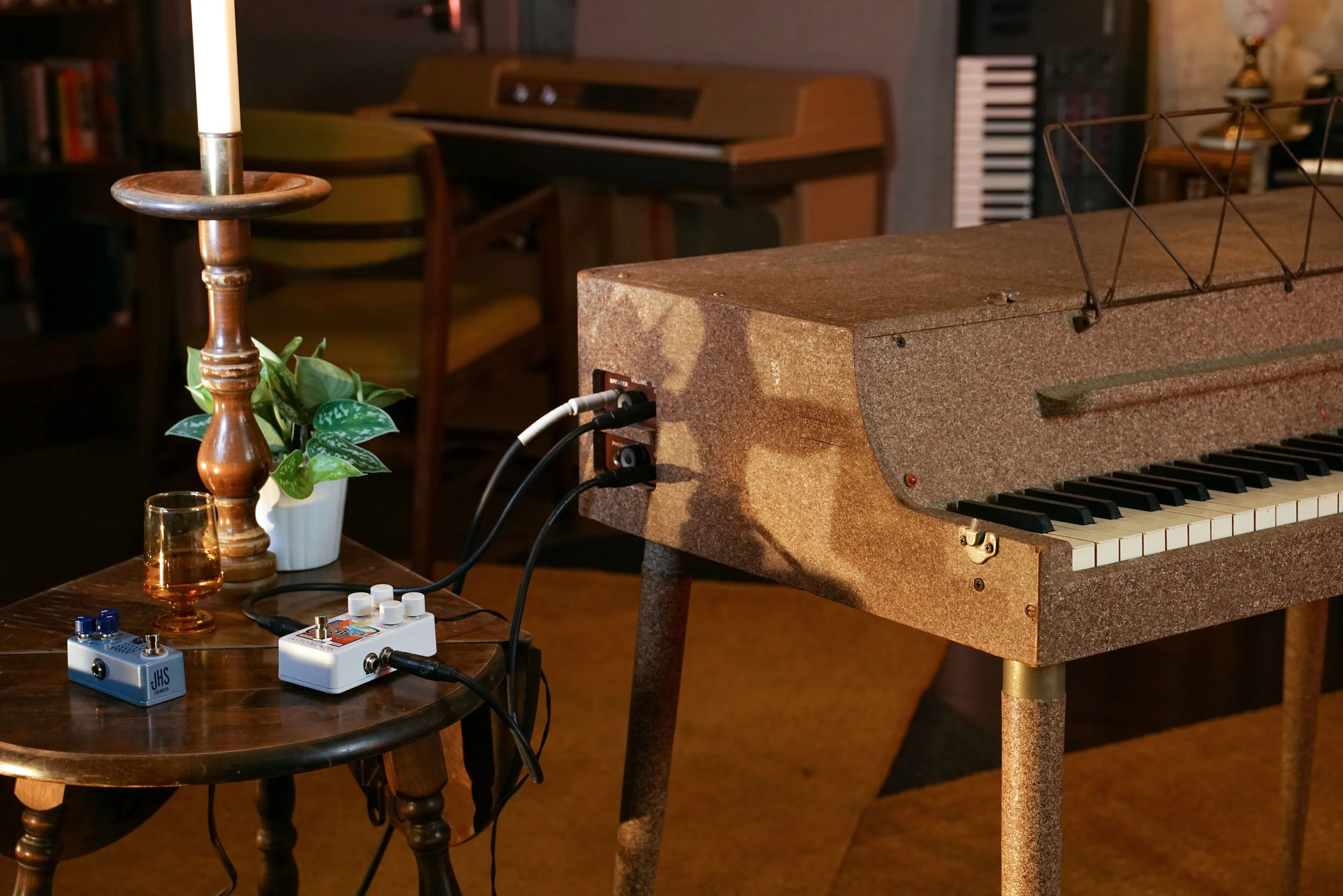The Wurlitzer 112, Explained
The Wurlitzer 112 was released in 1955. Excluding some prototypes, it is the first Wurlitzer electronic piano.
As the first of it's kind, the 112 has a lot of interesting features that were phased out in later iterations of Wurlitzer keyboards. First, the pedal is mounted to the side, rather than the bottom. By 1956, even the revised Wurlitzer 112A had a bottom-mounted pedal. Surviving original 112 pedals have become extremely rare.
The 112 also has a unique silhouette: slightly deeper and taller than later Wurlitzers. A vintage keyboard is never going to fade into the wallpaper, but the 112 has a clear presence in a room. Between its size, speckled paint, and midcentury lines, this is definitely a statement piece.
Like the 120 and 145, the 112 has a tube amplifier. This gives it an exceptionally warm and lush tone. There's just no plugin or emulator that compares to an authentic tube Wurlitzers. Even the transistor models of the 60s and 70s have their own sound: similar, but not exactly the same as their earlier counterparts.
The 112 was marketed towards parents, students, and home users. It was designed as an alternative to heavy, expensive spinet and upright pianos. It wasn't long before gigging musicians saw the appeal too. Although some musicians were skeptical about the Wurlitzer's tone (note that this piano was released decades before the synth age: nothing at the time sounded quite like it), most considered it an upgrade to the usually neglected and out-of-tune backline spinet. As Bill Crow describes in his memoir, From Birdland to Broadway:
I dropped in at the Plaza Hotel one night to hear Lionel Hampton's band. The hotel was trying a jazz policy in one of its restaurants, but had provided the band with a disgracefully out-of-tune spinet piano that had several broken keys. Hamp's pianist had pushed it aside and set up a little Wurlitzer electric piano that he carried with him on the road as a practice instrument. [...]
[Erroll Garner] and some friends came in and took a table in front of the bandstand. Hampton motioned for him to come up and play, and Hamp's pianist got up from the Wurlitzer to make room for him. Erroll sat down at the spinet instead, indicating his preference for the "real" piano. As he played one measure on the crippled spinet, his eyebrows shot up and his mouth made an O of surprise. He leaped up without missing a beat and continued his solo on the Wurlitzer. Even with its limitations, he made it sound wonderful.
Ads of the period boasted about the 112's convenient size and portability: the legs could be tucked into a lid, and the whole package could be carried about by its handle. (Theoretically. This Wurlitzer is not light: we thought that the handle was ornamental until we saw ads depicting happy Wurlitzer owners actually carrying it around by the handle. We recommend asking a friend to help you carry your vintage 112.)
In the age of digital keyboards, a hundred-pound keyboard with wooden legs and a thumbscrew-mounted pedal might not sound very convenient at all. But in the 1950s, when the only alternative was an actual piano, the Wurlitzer 112 was a revolution. Here was a piano that could go anywhere, anytime. You could bring it to a cocktail party. You could move it from the den to the dining room and back again. You could hide it in a closet when your kids gave up on their lessons.
Even before the electronic piano, Wurlitzer's biggest demographic was students and suburbanites. The company had always been interested in making pianos smaller and more affordable to families on a budget. In the 1930s, Wurlitzer introduced the spinet, essentially a pared-down version of the upright. This was a smaller, cheaper piano that came in trendy colors and finishes, so consumers could more easily match their piano to their home decor. The electronic piano was just the logical extension of Wurlitzer's longtime interest in making pianos more accessible to the average person.
Sleek and leggy, with a Formica-esque speckle (the height of design in the 1950s), the Wurlitzer 112 doesn't look like any piano that came before it. It's futuristic and on-trend, as befits an instrument on the cutting edge of technology. The Wurlitzer's modern lines and brightly colored cabinet call just as much attention to the parts that are absent: the strings, the soundboard. It was music and technology unified.
The 112 is a very cool, collectible piece of history that's still as functional as the day it was made. With an unmistakable sound and a midcentury silhouette that still commands a room, the 112 is definitely an underrated model. Although the action of later 200-series Wurlitzers is somewhat more user-friendly, nothing compares to the warm tube tone of an original. They're also becoming increasingly hard to find, particularly in complete condition (music rack, pedal, legs, and lid - not to mention original screws). This is definitely a worthy instrument that will add a one-of-a-kind sound to your music.






Further Reading
Browse all of our articles on restoring vintage gear. Or, click on an image below.






